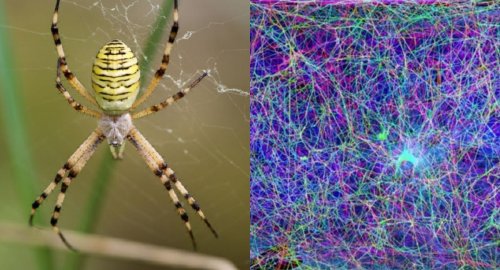
Scientists Translated Spider Web Structure into Music

- 9-08-2021, 18:30
INA – Sources
“Spider’s Canvas” features the sonification of a 3-D spider web, with each strand “tuned” to a different note. We may one day be able to communicate with spiders in the “language” of web vibrations.
In an attempt to better understand how the arachnids spin webs and communicate, MIT scientists have transformed the structure of a spider web into musical notes.
If you ever wondered what a spider web sounded like, scientists at the Massachusetts Institute of Technology (MIT) in the US have come up with the answer. Markus Buehler, an engineering professor at MIT, Ph.D., the project’s principal investigator, and his team created 3D models of spiderwebs when the arachnids were doing different things such as construction, repair, hunting and feeding.
After listening to the pattern in the spider signals, they created sounds for them using computers and mathematical algorithms.
Vibrations were recorded from spiders and artificial intelligence is used to learn these vibrational patterns and associate them with certain actions, basically learning the spider’s language.
While many who came across the video found the soundtrack to be eerie, others were left mesmerized. With the sonification, Buehler hopes it would help humans understand the language of a spider and someday communicate with them.
In the study, the team scanned a natural spider web with a laser to capture 2D cross-sections and then used computer algorithms to reconstruct the web’s 3D network. They assigned different frequencies of sound to strands of the web, creating “notes” that they combined in patterns based on the web’s 3D structure to generate melodies.
The researchers then created a harp-like instrument and played the spider web music in several live performances around the world and also made a virtual reality setup that allowed people to visually and audibly “enter” the web.
The team explored how the sound of a web changes as it’s exposed to different mechanical forces, such as stretching. In the virtual reality environment, we can begin to pull the web apart, and when we do that, the tension of the strings and the sound they produce change.
At some point, the strands break, and they make a snapping sound. Further, in a bid to communicate with spiders in their own language they recorded web vibrations produced when spiders performed different activities, such as building a web, communicating with other spiders or sending courtship signals. Although the frequencies sounded similar to the human ear, a machine learning algorithm correctly classified the sounds into the different activities.
Additionally, these experiments showed an algorithm able to correctly classify spider sounds into different activities. Even though they sounded similar to human ears, this means that the time when human beings learn how to communicate with spiders in their own language may not be that far away!
White House: Talks with Iran were very positive and constructive
- International
- 09:40
US Embassy: Trade Mission of 60 Companies Visits Iraq
- politics
- 25/04/07
CBI unveils comprehensive reform plan to modernize banking sector
- Economy
- 25/04/07
Al-Sudani Meets Delegation from J.P. Morgan Bank
- politics
- 25/04/08












